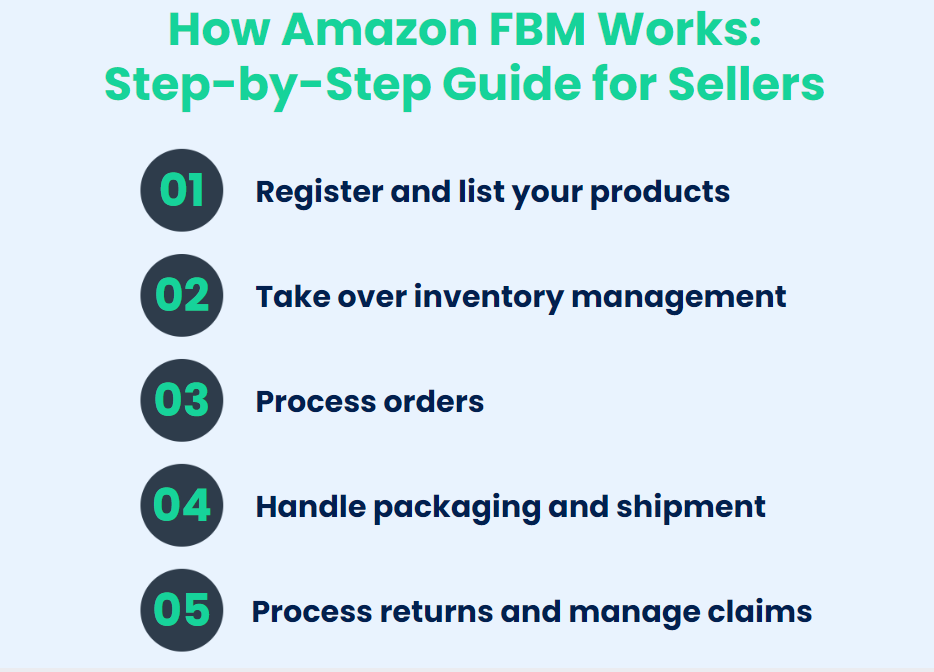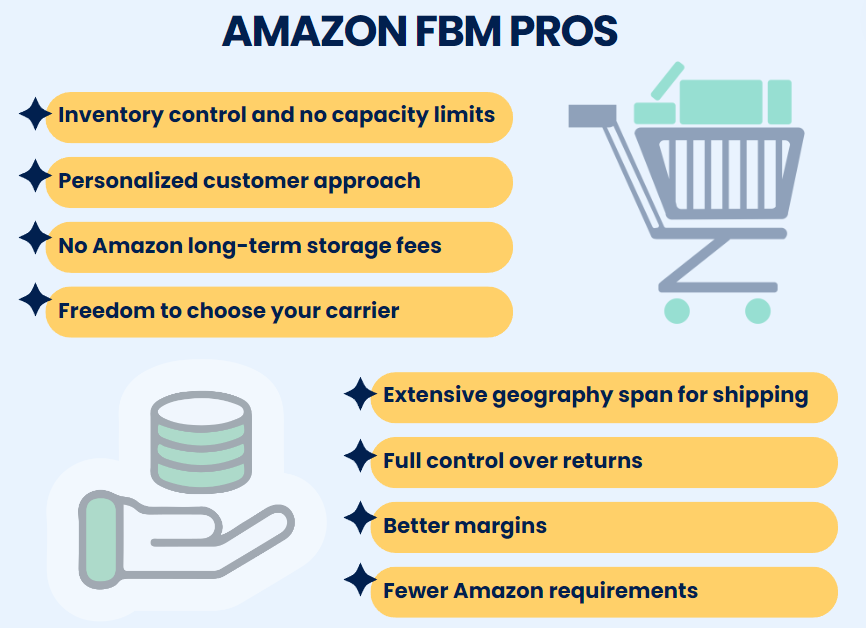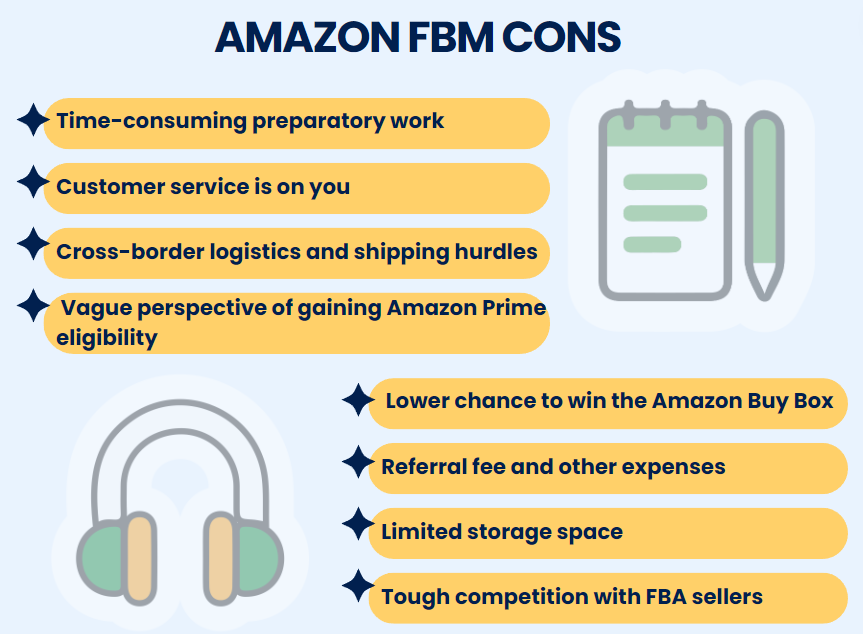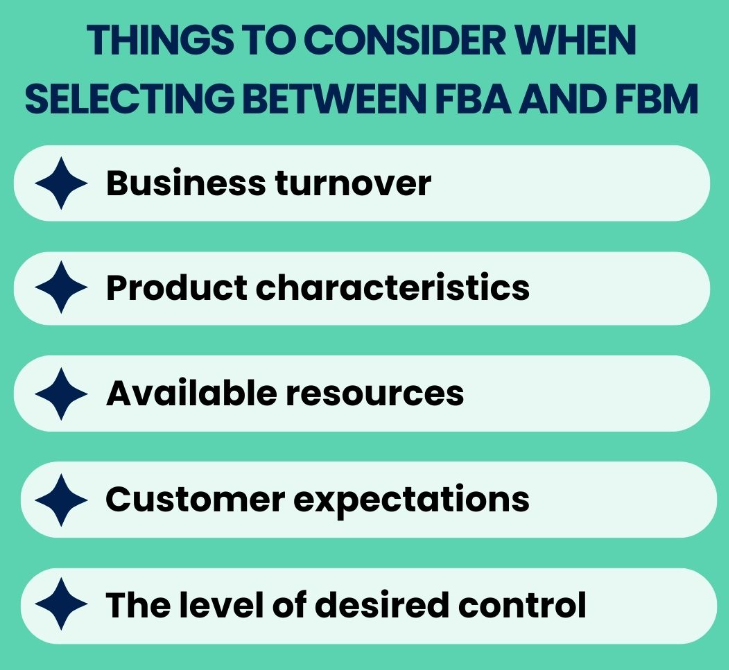If you’re a seller listed on the Amazon marketplace, you like no one else understand that just to sell a product isn’t enough. Before the item gets into the buyer’s hands, it goes through multiple stages: order processing, collection from the warehouse it’s stored at, shipping, and return if the buyer changed their mind to purchase or had some claims about the product.
Amazon, a world-known ecommerce and online retail marketplace boasts approximately 9.7 mln sellers worldwide, and offers two methods of selling – Amazon FBA and FBM. The FBA model implies that shipping and customer service-related things are the aggregator’s responsibility. The FBM (Fulfilled by Merchant) model is totally opposite, utilization of the model means that all these matters lie on the vendor’s shoulders. But in which cases FMB is the best choice for retailers? Let’s explore the main specifics of the model and find out.
Key takeaways
- Amazon FBM is the cooperation model offered by the marketplace, where a seller is fully responsible for order fulfillment.
- The FBM model perfectly suits merchants with relatively small turnover, selling bulky and heavy or unique and exclusive items.
- Amazon FBM merchants have wider opportunities for international shipping, may perform better control over the fulfillment process, and are empowered to provide personalized customer service.
- FBM sellers should be prepared for a comprehensive research of rules and regulations set by different countries to carry out international shipping.
What’s Amazon FBM
FBM is a model, using which merchants deal with fulfillment and shipping independently. In contrast to the Amazon FBA model, where the marketplace is responsible for product storage, packing and delivery, independent sellers manage their inventory themselves, carrying out product delivery and customer service. Simply put, they use the platform as an additional channel for sales orders.
How it works
Here are the main steps of working on the Fulfilled by Merchant model:
Step 1. Registration and product listing
A merchant signs up on the marketplace and creates product listings, indicating prices, characteristics and other details.
Step 2. Inventory management
The merchant is fully responsible for inventory management, including resupplying, item information updating, etc.
Step 3. Order processing
Once the merchant receives an order, they process the order and start preparing it for shipment.
Step 4. Packing and shipment
The merchant packs the order in compliance with the platform’s requirements to FBM sellers, and arranges shipment.
Step 5. Returns processing and claims management
FBM merchants deal with returns and process customer claims if any.

Why would I care and take this responsibility on myself if it can be undertaken by Amazon, you may ask. And of course, in many cases, the desire to entrust fulfillment to the marketplace is completely justified. Just let’s refer to the stats, showing that 94% of vendors listed on Amazon prefer the FBA model over FBM. But let’s dive a bit deeper into the topic, discuss the upsides and downsides of the Fulfilled by Merchant model, compare it with FBA in detail, and figure out cases when taking care of product delivery yourself is much more reasonable than entrusting it to the marketplace.
What’s good about Amazon FBM: Pros
As it’s already been mentioned, when you decide in favor of FMB, you’re responsible for all the stages your item goes through: starting from its storage before its delivery and ending up with responding to clients’ complaints if any.
At first glance, it may seem that there are no upsides at all, and FBA wins on all fronts due to the convenience the marketplace provides to merchants. However, don’t make hasty conclusions, let’s see what good you may find if you go with the option.

#1. Inventory control and no capacity limits
Keeping your saleable goods close means having better control over them. Merchants are empowered to respond to fluctuations in demand promptly and adjust pricing strategies accordingly. Additionally, there’s no need to worry about the capacity limits you’ll inevitably face when opting for the FBA model.
Not to be unfounded, let’s refer to the Amazon Seller Forum. Here’s what the marketplace replies to a customer asking about the notification regarding the expiration date: “At the time of check-in at Amazon fulfillment center, all products must have a remaining shelf life that allows sufficient time for the product to be consumed in full, plus an additional 90 days.”
#2. Personalized customer approach
Shifting the responsibility of shipping items on Amazon, you deprive yourself of the opportunity to provide a unique customer experience to your clientele. If you entrust packaging to Amazon, they ship your and other vendors’ items to customers in their own branded boxes.
Sure thing, we can’t speak about personalization with the FBA model and standard pack. But when you take responsibility for packaging, you’re free to customize your package (and also offer eco-friendly packaging options if it matters for your client) and therefore, strengthen relationships with your customers.
#3. No Amazon long-term storage fees
Amazon offers its own space for goods storage, and vendors can use it when opting for the FBA model. However, the related fees may not please you, especially if you sell high-volume items and need long-term storage for them.
By adopting the Fulfilled by Merchant model, the bad news is that product storage is your responsibility, and the good news is that you rid yourself of the necessity to pay costly fees to the marketplace. For example, the marketplace has a monthly inventory storage fee varying from $0.56 to $3.34 per cubic foot, charges fulfillment fees up to 4.37 per unit, has inventory removal and disposal fees up to $13.05 per shipment – and that’s not all. Using the FBM model, you don’t need to pay for the services and can define a more customer-friendly pricing strategy.
#4. Freedom to choose your carrier
Working upon the FBM model, you don’t rely on the platform in terms of delivery and are free to select the carrier that suits your needs. Let’s refer to the forum again, and here’s what the Amazon FBA seller says: “For the most part, most of the receiving goes smoothly, but there have been several issues that have caused a mess. Namely, it looks like the FBA team is mixing up the SKUs when they scan them and put their own labels over them. I have been routinely getting feedback that the wrong item was shipped”
Since you use FBA services for shipment, you have almost no control over the process. Being in charge of delivery yourself, you are free to select an appropriate and reliable vendor that would fit your requirements, and not to worry that packages would be mixed up or would be shopped with delays.
#5. More extensive geography span
The marketplace can ship products internationally and you’re free to use it if the marketplace supports the delivery to the destination. However, at the moment there are only 28 countries the platform can ship to in Europe, for example.
What if the country you want to ship your items to is not on the list and you don’t have access to Amazon fulfillment centers in your target location? The answer is to use your fulfillment infrastructure and resort to the services of local shippers, which you’re free to do with the Fulfilled by Merchant model.
Consistent shipping and sales regardless of external factors
Just remember COVID-19 times when it seemed that the entire world came to a halt. Amazon stopped shipments via FBA of products the marketplace considered non-essential for some time. As you may have understood, it affected a large number of merchants using the model, since their businesses were actually frozen.
In contrast to FBA sellers, those using FBM didn’t experience any changes in their operational workflows. Since they were responsible for fulfillment themselves and were independent of the platform in terms of delivery, this freeze didn’t affect them.
#6. Full control over returns
When the platform is responsible for fulfillment, you aren’t eligible to leverage your own policies and manage products returns accordingly. Therefore, the marketplace takes on the burden of returns management and meanwhile leverages its own policies. This means that you have quite limited ability to influence the return process, and all the products are returned directly to fulfillment centers.
For example, their standard return timeline is 30 days after receiving the product. Using the Fulfilled by Merchant model you’re able to set another return timeline and can set your own return policies. It’s you who processes inbound return requests and determines the return conditions.
#7. Better margins with fulfillment and selling fee handled
You gain the service – you pay for it. Amazon takes responsibility for your fulfillment and a selling fee, and the final service cost may turn out to be quite impressive. If you’re ready to deal with storage of your products, order processing, shipment, customer service, and return management yourself – you have an opportunity to cut costs and therefore, increase margins.
#8. Fewer Amazon requirements applicable to FBA sellers
Amazon establishes multiple requirements for products’ characteristics and its packaging. For example, if it’s a box, its weight mustn’t exceed 50 lbs, size must be no more than 25 inches, packaging materials mustn’t contain foam strips, or shredded paper and, and these are just a few requirements. Moreover, the marketplace may easily change them and provide little time to merchants for adaptation to new rules. FBA merchants have to strictly adhere to all these regulations and have no choice other than to adapt to changes promptly.
This doesn’t mean that there are no standards set for FBM merchants by the platform at all – of course, they exist on a par with penalties for their violations, but the amount of these rules is much less than in the case of the FBA model.
What’s bad about Amazon FBM: Cons
Sadly but predictably, there’s always another side to the coin. Below, let’s discuss some critical drawbacks of FBM that are worth mentioning if you consider it for launching your Amazon business.

#1. Time-consuming preparatory work and fulfillment steps
When you entrust fulfillment to the marketplace, there’s no need to complete any preparatory work. You can start delivery right off, and all the processes are worked through on the part of Amazon. But when you take it on your shoulders, there’s no way other than to establish all the steps of fulfillment on your own.
Searching for storage spaces and partners for delivery, packaging design development, elaboration of delivery and return policies – you need time to make these processes run like clockwork. But even when you’ve settled all the preparatory steps, don’t forget that this is not all and you’ll have to manage the entire process yourself. Let’s also pay attention to statistics: 20% of FBM merchants spend more than 40 hours per week on their Amazon business versus 16% of FBA merchants.
#2. Customer service is on you
Amazon is also responsible for customer service if you shift fulfillment to them. They deal with everything: customer inquiries, inbound complaints, chargebacks, returns, and other customer requests. When you select the Fulfilled by Merchant model, you’ll have to work with your clients and ensure prompt and satisfactory customer service yourself.
#3. Cross-border logistics and shipping hurdles
If you’re a FBM merchant on Amazon and plan to carry out delivery internationally, be ready for extensive research. Each country has its own customs regulations, fees, and import/export requirements, which you’ll have to explore before you start delivery. A good grasp of local laws and regulations is a must if you plan to provide timely delivery and minimize the risk of getting stuck at the border-crossing point because of non-compliance with local standards.
#4. Vague perspective of gaining Amazon Prime eligibility
The marketplace offers a Prime program implying quick and free delivery (within 1-2 days), which is understandably preferred by customers. But there’s one caveat – the platform unconditionally offers this privilege to sellers selling products through the FBA model. It doesn’t mean that those sellers using FBM aren’t able to gain this badge – absolutely not. It’s possible, but under several conditions set by Amazon:
- At least 90% of ordered products must be shipped on time;
- The rate of cancellations initiated by the merchant must not exceed 0.5%;
- 99% of orders must have accurate tracking information provided.
If you’re able to adhere to the mentioned rules – there’s a chance to benefit from the Amazon Prime program.
#5. Lower chance to win the Amazon Buy Box
What is the Amazon Buy Box? Buy Box is a prominent feature on a product page, which allows customers to add the selected item to a cart immediately and make a purchase. When there are multiple merchants on the product page participating in both FBA and FBM programs, the marketplace defines only one seller the Buy Box belongs to.
What is Amazon’s decision based on? There are multiple metrics the marketplace factors in. For example, if the item is in stock, its price, delivery speed, and the seller’s rating. And of course, customers prefer buying products from a seller featured in the Buy Box.
Although FMB merchants can compete for the Buy Box with FBA merchants, it’s not an easy task to tackle. As it has already been mentioned in the previous point, FBA merchants gain Prime status right away, while FBM merchants have to fulfill a range of various Amazon’s conditions. Therefore because of the initially uneven playing field, FBA merchants have much more opportunities to win the Buy Box in comparison with those working through the Fulfilled by Merchant model.
#6. Referral fee and other expenses
The FBA model offered by Amazon covers such costs as order handling, product storage, picking, packaging, and delivery. Using the Fulfilled by Merchant model you don’t have to pay all these fees to Amazon, but you are still required to pay to your vendors and your in-house staff. Therefore, it’s better to calculate your potential expenses in case of usage of both programs, compare them, and make a data-driven decision in favor of a more advantageous option afterward.
It’s also worth mentioning that the platform also charges a referral fee – no matter if you’re a FBA merchant or deal with fulfillment yourself. If you sell an item the marketplace usually charges around 15% of the total price (the percentage may vary though, depending on the category). The difference is that FBA sellers pay to the platform 15% of the purchased price, while FBM sellers pay 15% of the item price and additional services, such as delivery, gift wrapping, etc.
For example, a buyer purchased your item via the marketplace for 100 USD. You also have a shipping fee of 5 USD, plus gift wrapping for 10 USD, so the total amount the customer pays will be 115 USD. Therefore, Amazon’s charge will be 15% of the total amount, including shipping and wrapping.
#7. Limited storage space
The marketplace holds a huge amount of warehouses worldwide, that can be used for storage of products of different sizes and weights. Using Amazon’s facilities you don’t have to care about limited storage space and can safely place bulky and heavy things there.
With the Fulfilled by Merchant model, you have to use your own storage space or rent it from a vendor. But what happens if your own space is limited and there’s no possibility to place more products? Or if the vendor leasing a warehouse to you changed his/her mind and decided to terminate the leasing agreement? Both cases imply searching for new storage facilities and expenses for transportation of stored items.
#8. Tough competition with FBA sellers
Which do you prefer: get your order shipped within 1-2 days for free or wait for a week or two and pay for delivery? Not sure that the second option is more attractive than the first one for you and the vast majority of Amazon buyers. Therefore, a huge percentage of purchasers look for products with the Prime badge to gain their shipment as soon as possible and without any additional charges.
As it was mentioned before, the platform assigns the Prime status unconditionally to Amazon FBA merchants only, while those working through the FMB model have to fulfill a number of conditions set by the marketplace. Therefore, companies using different fulfillment models offered by the platform have unequal competitive conditions from the very beginning, which is a significant drawback for FBM merchants.
Nailing your Amazon accounting with automation
Regardless of the Amazon model you choose (FBA or FBM), you’ll still need a reliable tool to simplify accounting and make sure you save valuable time and can actually use it to advance your business.
Synder Sync offers a lifeline to businesses grappling with Amazon accounting and provides a range of powerful features geared towards simplifying financial processes and ensuring meticulous record-keeping.
One of the most significant perks Synder brings to the table is its seamless integration between Amazon (and any other marketplaces and payment platforms) and your accounting system (QuickBooks Online/Desktop, Xero, Sage Intacct). There are 30+ integrations available, so you can manage your accounting in one source of truth.
With Synder, businesses can eliminate manual data entry, as it effortlessly exports Amazon transaction data to the accounting system you use without any risk of duplicates or errors.
Synder’s real-time data synchronization capabilities allow merchants to keep a finger on the pulse of their finances. By instantly integrating Amazon sales data into their books, Synder provides a clear and current snapshot of your financial health, empowering you to make data-based decisions on the fly.
Preparing for tax season becomes a lot less stressful with Synder, as with accurate records at all times reconciliation is quick and painless. How? By meticulously pre-checking all transactions recorded in your accounting from various platforms, including Amazon, Synder helps ensure that your financial records are squeaky clean and compliant with tax regulations, sparing you from any unwelcome surprises down the road.
Synder’s automated categorization feature is another thing busy Amazon business owners truly benefit from. With the ability to create personalized rules for categorizing Amazon products and completing missing data in, for example, QuickBooks, Synder takes the grunt work out of tailoring their accounting flows to their needs.
Additionally, Synder supports various other aspects of Amazon accounting, from withheld tax tracking to multicurrency management.
Synder is ready to automate a great chunk of your Amazon accounting. Tap the link to start a 15-day free trial and start improving the efficiency of your business, or visit our Weekly Public Demo to find out more.
Aspects to consider when swinging between FBM and FBA for product selling
Both Amazon models have their pros and cons, and selecting the right option right away seems to be a real challenge. Therefore, it’s important to consider aspects that are essential particularly for you, taking into account all your business specifics and needs. Let’s go over some factors that may help you make an informed decision and to avoid any mistakes.

Aspect #1. Business turnover
Imagine that your company sells computer mice via Amazon and gains 400 orders per week, which is 1600 orders per month. Selling through FBA, you have three expenditures: fulfillment (which includes picking, packing, and delivery), storage, and inbound shipping. For such mass-market goods that are sold like hotcakes, fees aren’t that significant with FBA.
And now let’s consider another situation, where you’re an Amazon seller of exclusive mahogany-made wardrobes. What do you think, is it possible to ship 400 items per week as in the case of computer mice? The answer is quite obvious – no. It’s not a mass-market product, and it’s much more expensive than the piece of electronics we’ve mentioned. Therefore, the turnover will be much lower too. Say, you sell 4 items per week, which is only 16 items per month. The math speaks for itself.
As you may have guessed, FBA costs with such a small turnover will be sky-high, and turning your eyes to the Fulfilled by Merchant model offered by Amazon will be much more reasonable.
Aspect #2. Characteristics of your saleable products
Since we’ve already provided an example with computer mice and exclusive mahogany-made wardrobes, let’s consider the same items and review another aspect besides the mass character – item size and weight.
Obviously, a computer mouse is something you may easily drop into your pocket, while with a bulky and weighty wardrobe, this trick won’t work. The FBA model doesn’t have a very nice pricing policy for large-sized and heavy products, and in combination with the small turnover, your expenses for Amazon services may be way above your limits.
Therefore, the point is simple – it’s more reasonable to sell compact lightweight goods through FBA, while FBM is a preferable choice for bulky and heavy products.
Aspect #3. Resources at your disposal
Selecting the right model also depends on the resources you have at the moment. If you have a storage facility for your items, collaborate with reliable suppliers, manage order processing and customer service in-house, and understand international delivery customs regulations, you’re well-equipped to benefit from the Fulfilled by Merchant model. And if you’re open to investing in distinctive package designs, there’s nothing to stop you from adopting this approach.
Aspect #4. Customer expectations
Before selecting a model, it’s better to understand the requirements your target audience imposes on your services. It’s not likely that a buyer who had purchased earbuds via Amazon would require exclusive packaging and individual approach when making a purchase via the website. Something suggests that the customer would prefer fast and free delivery instead.
Meanwhile, it’s totally different if we deal with non-mass exclusive products. Customers who are ready to purchase something unique, luxurious, and expensive via Amazon may value personalization more than quick and charge-free delivery. Therefore, it’s always a good idea to analyze your customers’ preferences when opting for one of these two models.
Aspect #5. The level of control over the fulfillment and shipping process
Some say: if you want to do it right – do it yourself.
Those who aren’t ready to relinquish control over fulfillment to even such a trusted marketplace as Amazon, would rather take over all the complexities related to the process. These merchants prefer keeping their inventory close, stand ready to elaborate on return policies, and provide personalized customer experience, which is completely justified if we speak about specific and unique items.
Concluding lines: How to choose the model wisely
No matter how sorry, but the one-size-fits-all approach hasn’t been invented yet. The choice between two options for selling on Amazon may be quite tough, and the selection of the wrong one may entail undesirable financial losses. Therefore, it’s better to remember the saying “Measure twice – cut once”.
Before selecting this or that option, it’s essential to evaluate your ecommerce business from all angles. Consider your item range, customer expectations, available resources for fulfillment, desired level of control, and readiness to comply with shipping regulations for international destinations. All these aspects play an important role in decision-making, and only after you assess them carefully, you’ll be able to opt for the most appropriate option that’ll bring real value to your Amazon business.

.png)




